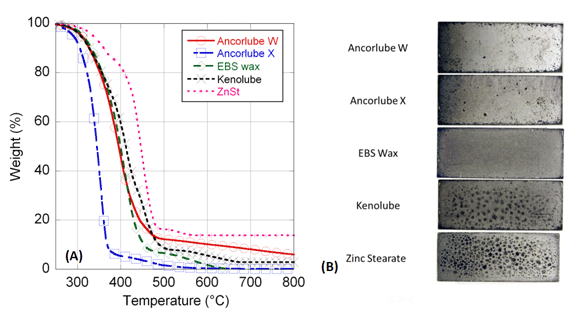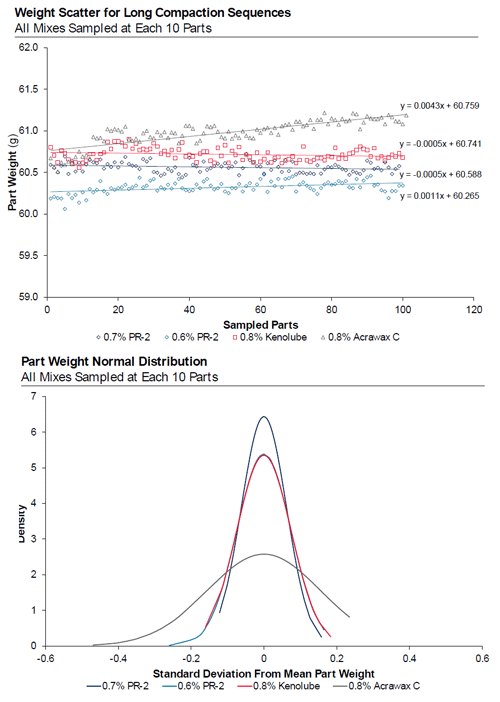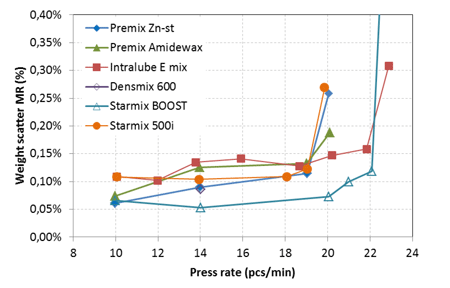Euro PM2013: Spotlight on Powder Metallurgy lubricants
Lubricants for Powder Metallurgy is a subject that often receives less attention at PM conferences than other materials related areas. Nevertheless, particularly for manufacturing high performance PM components with increasing complexity, the proper choice of lubricant is important and significant progress has been made recently in the development of special lubricants for iron and steel powders.
Session 6 of Euro PM2013 was completely dedicated to innovative lubricants. Besides the classical evaluation of apparent density, flow rate and compressibility, the ejection forces, part-to-part consistency and kinetics of the lubricant burn-off process were investigated. Lubricant developments were covered by presentations from leading iron and steel powder suppliers and Chalmers University of Technology.
Seshendra Karamchedu, Chalmers University of Technology, Gothenburg, Sweden, had investigated the lubricant burn-off of synthetic EBS wax from chromium containing PM steel powder compacts. Since chromium in PM steels is particularly sensitive to oxidation, lubricant burn-off in an oxidising atmosphere must be avoided.
The success of delubrication was measured by impact testing, inspection of the fracture surfaces by SEM and EDX analysis of the oxygen content both after delubrication and after sintering. The best results were obtained after delubricating at 450°C in a dry nitrogen atmosphere and sintering at 1120°C in argon/10% hydrogen gas.
Peter Sokolowski, Hoeganaes Corporation, compared the properties of innovative lubricants Ancorlube W, Ancorlube X, EBS wax and Kenolube. Without going into a detailed discussion of the results it can be said that iron base powder mixes with Ancorlube have similar powder handling characteristics as mixes with EBS wax and slight advantages in compressibility.
The ejection force (stripping force) at room temperature lies between those of EBS wax and Kenolube mixes, but at 75°C it is clearly lower than the two other mixes. Ancorlube X is reported to burn off at significantly lower temperatures than the other lubricants of the comparison and to leave a cleaner surface finish.
Another innovative lubricant for iron and steel powders, the proprietary formulation PR-2, was introduced by Vincent Paris, Rio Tinto, Canada. PR-2 was compared with Acrawax C and Kenolube in mixes with iron powder ATOMET 1001, 2% Cu and 0.55% graphite. The authors investigated the amount of powder filled into a set of rectangular dies of diminishing width and found similar apparent densities, but the weight scatter was significantly less for the PR-2 mixes.
The authors concluded that the part-to-part consistency is better for components made with PR-2 lubricant and confirmed this with a compaction series of 100 cylindrical bushings with 25.4 mm diameter, 25.4 mm height and a wall thickness of 5.6 mm. Powder mixes with PR-2 again showed a clearly lower weight scatter than mixes with Acrawax C or Kenolube (Fig. 2).
A comparison of newly developed Lube E with zinc stearate, amide wax, DM120 and BOOST lube in mixes with Astaloy 85 Mo + 0.5% graphite was presented by Mats Larsson, Höganäs AB, Sweden. The lubricant contents were varied between 0.5% and 1.0% by weight.
The bonded mixes Densmix 600 with DM120 for warm compaction and Starmix 500i with Lube E and Starmix BOOST with BOOST lube excelled in flow rate and apparent density.
Cylindrical samples of 25 mm diameter and 20 mm height were pressed on a hydraulic laboratory press to study the compressibility and lubrication. The highest compressibility at room temperature was achieved by zinc stearate. The ranking of lowest ejection energy was led by Densmix 600, Starmix 500i and Starmix BOOST.
Further it was found that the weight scatter largely depends on the press rate, and if a critical press rate is exceeded, the weight scatter increases dramatically. Starmix BOOST and Intralube E mix allowed the highest press rates (Fig. 3).
Yannig Thomas, National Research Council, Canada contributed a fundamental study on the effect of lubricant particle size. He investigated the compressibility and lubrication of mixes with ATOMET 1001HP + 1.8% Cu + 0,7% graphite with 0.7% EBS lubricant in cold compaction at room temperature and warm compaction in a die which was heated to 60°C. The average particle size D50 of the lubricant was varied between 2.5 µm and 25 µm.
The stripping shear stress was found to decrease by approximately 10% with increasing particle size, the lowest value being achieved with D50=25 µm. However, the compressibility with this lubricant particle size was approximately 0.05 g/cm³ less than with D50=15 µm. This was observed in cold compaction as well as in warm compaction. A lubricant particle size of D50=15 µm appeared to be the most suitable one.
Author: Dr Georg Schlieper, Gammatec Engineering GmbH, Germany
Dr.-Ing. Georg Schlieper, physicist, received his PhD at the Insitute for Materials and Solid State Research of the University of Karlsruhe, Germany. He worked for 15 years in product and process development for the Powder Metallurgy industry where he focused on high strength sintered steels, heat treatment, surface technology, magnetic materials and metal injection moulding. Since 1994 he has worked independently as a consultant. Email: [email protected]








